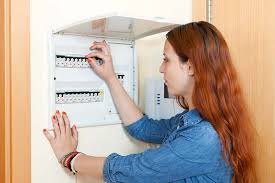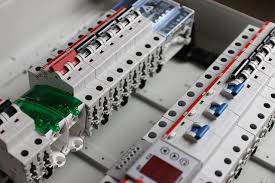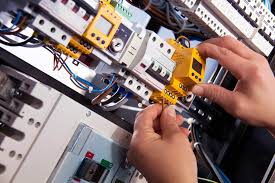Gfci Receptacle Vs Gfci Circuit Breaker: What’s The Difference?
What Is a GFCI Receptacle?
You can tell if a receptacle is a GFCI one or not by the way it looks. The GFCI is integrated into an electrical outlet and it typically has a red (or possibly white) reset button on the outlet’s faceplate. The outlet monitors how much energy is going into it when in use. If the receptacle senses any sort of an electrical overload or imbalance, it is designed to trip the circuit in a fraction of a second.
GFCI receptacles are generally used instead of a standard outlet receptacle to offer protection to a single outlet location. However, GFCI receptacles can be wired in two different ways to offer two different levels of protection. Single-location protection offers GFCI protection only at one receptacle. Multiple-location wiring protects the first GFCI receptacle and every receptacle downstream of it (including standard receptacles) in the same circuit. However, it does not protect the portion of the circuit that lies between itself and the main service panel. For example, if the GFCI receptacle wired for multiple-location protection is the fourth receptacle in a circuit that includes seven outlets, then the first three outlets will not be protected.
Resetting a receptacle is typically more convenient than going all the way to the service panel to reset a breaker, but remember that if you wire a circuit for multiple-location protection from a single GFCI receptacle, that receptacle controls everything downstream. If there is any wiring issue downstream, you will have to backtrack to find the GFCI receptacle to reset it.

What Is a GFCI Circuit Breaker?
GFCI circuit breakers protect the entire circuit. GFCI circuit breakers are simple: By installing one in the service panel (breaker box), it adds GFCI protection to an entire circuit, including the wiring and all devices and appliances connected to the circuit. In cases where AFCI protection is also called for (increasingly common), there are dual function GFCI/AFCI circuit breakers that can be used.
GFCI circuit breakers make more practical sense in situations where all outlets on a circuit require protection. For example, let’s say you’re adding a receptacle circuit for a garage workshop or a large outdoor patio space. Because all of these receptacles require GFCI protection, it is probably more efficient to wire the circuit with a GFCI breaker so that everything on the circuit is protected.

How do you decide whether a GFCI breaker or receptacle is right for you?
Both GFCI breakers and receptacles can increase the safety in your home and reduce the risk of electrical shocks, but there are pros and cons to each, and determining which option is right for you will depend on the individual circumstances.
When to Install a GFCI Breaker:
- When the majority or all of the outlets on the circuit require GFCI protection
- When outlets that require GFCI protection don’t have the space for the bigger GFCI receptacles
- For specialty uses, like for heated swimming pools
- For those who prefer to protect the entire circuit rather than individual outlets
When to Install a GFCI Receptacle:
- When a single circuit powers some outlets that require GFCI protection and some that don’t
- When you need GFCI outlets but don’t want the added expense of installing a GFCI breaker
- When the individual receptacle that needs GFCI protection is located far away from the breaker box

3 Wiring Problems Causing Your Circuit Breaker to Trip
Before we list the wiring problems that may be behind this problem, quickly check to make sure you haven’t forgotten about a device that’s plugged in and on.
Sometimes, people forget about gadgets in their garage or plugged in outside.
Provided that’s not happening, here are three wiring problems to consider.
1. Current Leakage
One possibility is that one or more of the input wires is suffering from current leakage.
In that case, the frustrating problem you’re experiencing is actually occurring for your own good. It’s a safety precaution.
2. Damaged Wires
The damage could be anywhere, not just with the input wires. Insects or other pests may have gotten to them and done serious damage just by chewing. Even with extremely low loads, this type of problem can be enough to cause your breaker to trip.
3. A Loose Wire in an Outlet
This wiring problem can be maddening. In short, one of your outlets has a loose wire that is causing your breaker to trip and will continue to do so until it’s replaced. This is a somewhat common problem if you have an outlet with a GFCI (Ground-Fault Circuit Interrupter).
How Many Outlets Can Be Placed on a 20 Amp Household Circuit?
The circuit breakers in the electrical panel in your house are safety devices. Each one is designed to disconnect power when the current passing through the circuit exceeds its rating. This prevents overheated wires, electrical power surges and fires. Electrical outlets don’t draw power until you plug something in, so a 20-amp circuit should theoretically be able to handle as many outlets as you want without overloading the breaker. There are practical limits, though.
Allowable Breaker Load
The National Electrical Code doesn’t limit the number of receptacles you can place on a 20-amp circuit, but you’ll overload the breaker if you run appliances that draw more current than the breaker can handle. The NEC does specify that a circuit breaker shouldn’t handle more than 80 percent of the load for which it is rated unless the breaker is labeled otherwise. By this standard, the total current draw on a 20-amp circuit shouldn’t exceed 16 amps. This allows the breaker to handle the temporary surge that happens when an appliance such as a power saw or air conditioner starts up.
Avoiding Overloads
When deciding how many receptacles to add to a 20-amp circuit, consider what you are likely to plug into each one. For safety, the total draw on the circuit shouldn’t exceed 16 amps at any one time, which translates to a maximum power draw of 1,920 watts on a conventional 120-volt circuit, even though the breaker won’t trip until the power draw exceeds 2,400 watts. You should limit the number of receptacles on a circuit that will handle a power-hungry appliance. For example, most electric heaters draw 1,500 watts, so a circuit that powers one should have few other receptacles.
Spreading the Load
To better distribute the power consumption among all the breakers in the panel, combine lights and electrical outlets on a single circuit, because lights typically draw less power than appliances. Your kitchen must have at least two outlets, each on separate circuits, so that if one breaker trips, you still have power. Adding lights to each circuit balances the load and avoids the necessity for separate lighting circuits. Certain kitchen appliances, however, such as the dishwasher, must be on a dedicated circuit, which means that you can’t include anything else on the circuit — not even lights.
General Guidelines
In most circuits, only one outlet is likely to be in use at any one time, so it’s a good strategy to spread as many as possible around the house on a single circuit to guarantee you have power where you need it. One rule of thumb is to assign a maximum draw of 1.5 amps to each receptacle, which allows for 10 receptacles on a 20-amp circuit. You must use 12-gauge wire to connect 20-amp circuits; when you’re installing receptacles in the bathroom, kitchen, laundry room or outdoors, they must generally be ground fault interrupting receptacles.